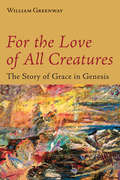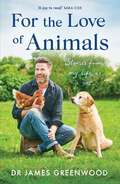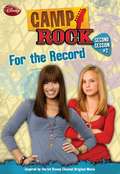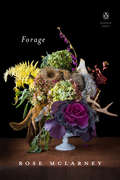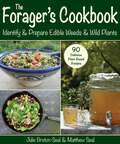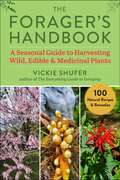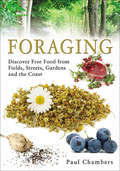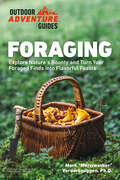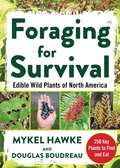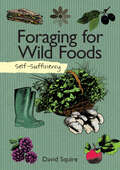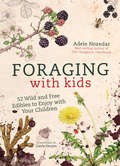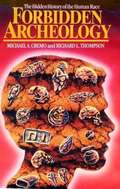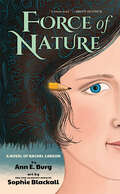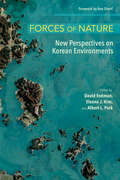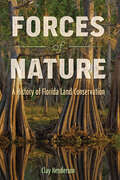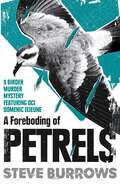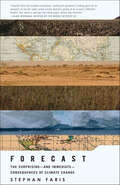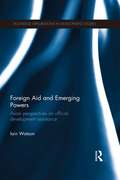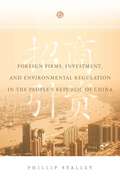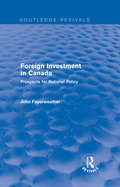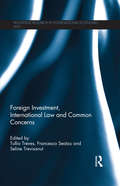- Table View
- List View
For the Love of All Creatures: The Story of Grace in Genesis
by William GreenwayFresh biblical take on a transcending, divine grace that embraces all of God's creatures This broad-ranging, groundbreaking book by William Greenway unfolds a biblical spirituality centering on love for all creation and all creatures. Greenway rereads the creation and flood narratives in Genesis from an overtly creature-loving perspective that not only inspires care for creation but also reveals sophisticated understandings of faith, grace, and evil vital for twenty-first-century spirituality. Comparing the ancient Israelite cosmology of Genesis both with the ancient Babylonian cosmology of the Enuma Elish and with the modern Darwinian cosmology of Thomas Hobbes's Leviathan, Greenway shows how the Bible in Genesis extends far beyond those other cosmologies in its discernment of the transcending, gracious love of God. Standing at the intersection of animal rights, "green" biblical studies, and philosophical theology, Greenway's For the Love of All Creatures will interest and inform a wide range of readers.
For the Love of All Creatures: The Story of Grace in Genesis
by William GreenwayFresh biblical take on a transcending, divine grace that embraces all of God's creatures This broad-ranging, groundbreaking book by William Greenway unfolds a biblical spirituality centering on love for all creation and all creatures. Greenway rereads the creation and flood narratives in Genesis from an overtly creature-loving perspective that not only inspires care for creation but also reveals sophisticated understandings of faith, grace, and evil vital for twenty-first-century spirituality. Comparing the ancient Israelite cosmology of Genesis both with the ancient Babylonian cosmology of the Enuma Elish and with the modern Darwinian cosmology of Thomas Hobbes's Leviathan, Greenway shows how the Bible in Genesis extends far beyond those other cosmologies in its discernment of the transcending, gracious love of God. Standing at the intersection of animal rights, "green" biblical studies, and philosophical theology, Greenway's For the Love of All Creatures will interest and inform a wide range of readers.
For the Love of Animals: Stories from my life as a vet
by Dr James Greenwood'A joy to read' - SARA COXGrowing up in Yorkshire and with farming blood in his genes, James Greenwood always knew he would end up as a vet.Animals have been part of James' life for as long as he can remember, from pulling lambs on a hilltop farm as a child and having stick insects crawling out of his school uniform in class, to renting a flat behind a zoo in Jersey and finding himself treating a newborn baby elephant as a newly qualified vet. Written with his trademark warmth and humour, James offers a fascinating insight into the world of veterinary medicine with tales of treating cats and dogs, horses, pigs and cows, as well as delving deep into his relationship with his beloved and much-missed, one-eyed Labrador, Oliver.However, the path to realising his childhood ambition has not always been easy and at times he has questioned whether it truly is the best job in the world. Through all of the challenging lows and extraordinary highs, it has been the animals themselves that have spurred James on to want to continue vetting and helping him find his calling as a GP vet. Warm, poignant and full of heart, James' story is both a beautiful tribute to the role animals play in our lives and a rare glimpse into what it's really like to be a vet, and is perfect for fans of Matt Baker, The Yorkshire Shepherdess and The Supervet.
For the Love of Animals: Stories from my life as a vet
by Dr James Greenwood'A joy to read' - SARA COXGrowing up in Yorkshire and with farming blood in his genes, James Greenwood always knew he would end up as a vet.Animals have been part of James' life for as long as he can remember, from pulling lambs on a hilltop farm as a child and having stick insects crawling out of his school uniform in class, to renting a flat behind a zoo in Jersey and finding himself treating a newborn baby elephant as a newly qualified vet. Written with his trademark warmth and humour, James offers a fascinating insight into the world of veterinary medicine with tales of treating cats and dogs, horses, pigs and cows, as well as delving deep into his relationship with his beloved and much-missed, one-eyed Labrador, Oliver.However, the path to realising his childhood ambition has not always been easy and at times he has questioned whether it truly is the best job in the world. Through all of the challenging lows and extraordinary highs, it has been the animals themselves that have spurred James on to want to continue vetting and helping him find his calling as a GP vet. Warm, poignant and full of heart, James' story is both a beautiful tribute to the role animals play in our lives and a rare glimpse into what it's really like to be a vet, and is perfect for fans of Matt Baker, The Yorkshire Shepherdess and The Supervet.
For the Record (Camp Rock #2)
by Lucy RugglesWhen a record executive arrives at Camp Rock, Tess is determined to outshine everyone and land the recording deal of a lifetime. The only problem? The record executive isn't at camp for the singing, he´s there for the food! Now Tess will have to get help from the unlikeliest of people--Mitchie.
Forage (Penguin Poets)
by Rose McLarneyA poet acclaimed for "uncompromising, honest poems that sound like no one else" (The Rumpus) now offers considerations of the natural world and humans' place within it in ecopoetry of both ambitious reach and elegant refinementRose McLarney has won attention as a poet of impressive insight, craft, and a "constantly questioning and enlarging vision" (Andrew Hudgins). In her third collection, Forage, she continues to weave together themes she loves: home, heritage, the South, animals, water, the environment. These intricately sequenced poems take up everything from animals' symbolic roles in art and as indicators of ecological change to how water can represent a large, troubled system or the exceptions of smaller, purer tributaries. At the confluence of these poems is a social commentary that goes beyond lamenting environmental degradation and disaster to record--and augment--the beauty of the world in which we live.
The Forager's Cookbook: Identify & Prepare Edible Weeds & Wild Plants
by Julie Bruton-Seal Matthew SealMore than a recipe book, more than a foraging book, more than a guide to herbal medicine. Discover 90 exciting recipes showcasing weeds that are delicious, nutritious, medicinal, too good to waste—and free!Why should we eat our weeds? Because they are delicious, adding a palate of new flavors in everyday cooking. They are also nutritious and too good to waste. Weeds are actually more nutritious than most of the vegetables we grow or buy. They often have deep roots that loosen the soil and bring minerals up from far below. Weeds can help cover the soil, keep moisture in it, and preserve its fertility. They offer a second crop among our other plants, for free, and are often available in the late winter and early spring when our vegetables are yet to get going. When it's time to weed, the edible weeds can be eaten. Why throw perfectly good food on the compost heap?With weeds, as with all wild plants you may be planning to eat, proper ID is essential. Rule number one is eat only what you are sure of. In this book, Julie Bruton-Seal and Matthew Seal have provided clear photographs and other written identification details for twenty-two common weeds. They also give guidance on how to harvest safely and responsibly. And you'll find ninety delicious recipes highlighting your foraged goodies. Recipes include:Chickweed PestoDaisy TeaDandelion Flower JamElderberry VinegarOrache TartGround Ivy Hot Cross BunsHogweed PaellaMugwort and Mushroom SoupAnd more!
The Forager's Handbook: A Seasonal Guide to Harvesting Wild, Edible & Medicinal Plants
by Vickie ShuferLearn the way of the forager and identify, harvest, and prepare wild plants by season. Have you ever wondered what it would be like to gather wild plants growing around you for your food and medicine instead of a drugstore to treat a common ailment? The Forager's Handbook is an essential guide for living this lifestyle year-round. With more than forty years of experience in the world of plants, forager Vickie Shufer empowers you to maintain and improve your health by following the way of the forager. She highlights plants that are available through each season and how to use those plants for food and medicine. Sustainable harvesting and preparation techniques are included as well as foraging ethics. Other topics include: Forest bathing Plant cyclesPreventive medicineSimple recipes for edible and medicinal plantsAnd so much more Follow the seasons and harvest wild, edible, and medical plants with The Forager's Handbook.
Foraging: Discover Free Food from Fields, Streets, Gardens and the Coast
by Paul Chambers&“A useful and practical field guide&” to finding delicious, indigenous edibles—full of color photos and including a forager&’s calendar (The Countryman). Long before there were convenient supermarkets, foraging for edible plants was as essential to survival as hunting and farming. For today&’s forager, it&’s a fun and practically free way to eat fresh and get to know your local environment. In Foraging, naturalist author Paul Chambers gives you the knowledge and knowhow you need to start going on your own foraging adventures. Focused on the British Isles, this comprehensive guide includes lists of indigenous edible plants, arranged alphabetically and by region. A full range of environments are covered, from the fields and forests of the countryside to suburban gardens, city streets, and even the coast. Chambers offers practical tips for identifying, collecting, preparing, and preserving forageables, as well each plants&’ historical, cultural, and medicinal meanings and uses. Packed with helpful illustrations and trivia, this volume is the result of years of experience and a passion for naturalism, and shares more than one hundred plants suitable for eating.
Foraging: Explore Nature's Bounty and Turn Your Foraged Finds Into Flavorful Feasts (Outdoor Adventure Guide)
by Mark VorderbruggenFind edible plants anywhere in North America!Foraged delicacies have become the latest foodie obsession. Wild edibles collected by professional foragers are proliferating on the plates of top-tier restaurants because they offer novel and ultra-fresh sensations for the tongue, and they frequently taste more flavorful than farmed foods. For people seeking new food experiences and wanting to forage for themselves, Idiot&’s Guides: Foraging shows how to find wild edibles and when and how to harvest them. Includes over 30 tasty recipes that describe how to prepare these wild foods.- Includes common plants all across North America.- Covers positive plant identification.- Multiple large, full-color photos identify each plant (including the mature plant, how it looks at various stages of growth, and how it looks at the right stage of growth for harvesting).- Each entry gives facts on the plant's habitat, physical properties, which parts are edible, harvesting sustainability, preparation, storage, and poisonous look-alikes.-More than 30 delicious recipes.-Includes range maps and charts that list plants by habitat and by season.
Foraging for Survival: Edible Wild Plants of North America
by Douglas Boudreau Mykel HawkeWhether you&’re a hiker taking a walk through your local wilderness, or a chef looking for new ingredients to incorporate in your dishes, Foraging for Survival is the book for you. As consumerism and a meat-heavy, processed diet become the norm and the world&’s population continues to grow at an exponential rate, more and more people are looking toward a more sustainable path for food. Authors Douglas Boudreau and Mykel Hawke believe that the future of food lies in the wild foods of times spanning back to before the mass-agriculture system of today. People have become distanced from the very systems that provide their food, and younger generations are increasingly unable to identify even the trees in their backyards. In response, Boudreau and Hawke have provided a compendium of wild edible plants in North America. Foraging for Survival is a comprehensive breakdown of different plant species from bearded lichen to taro, and from all over the United States. There are also tips for growing local native plants in the backyard to facilitate learning and enhance table fare at home. Other information you&’ll find inside: A list of different types of edible wild plantsForaging techniquesBugs and other grubs that can be consumedWarning signs of poisonous plantsAnd much more! Start eating wild today with Foraging for Survival!
Foraging for Wild Foods (Self-Sufficiency)
by David SquireWith delightful illustrations and fascinating facts aimed at young readers, this children&’s book explores the natural world of riverbanks. Have you ever wondered how and why beavers build their dams, how otters live, or how frogs come to be? Now you can find out! This charming picture book teaches young children what it&’s like to be an animal living on and in the water. With each turn of the page, this volume reveals dozens of adorable illustrations, educational captions, and vocabulary words. From beavers and otters to snakes, frogs, newts, and more, children will love learning all about these busy aquatic animals and the amazing lives they live! This is a fixed-format ebook, which preserves the design and layout of the original print book
Foraging with Kids: 52 Wild and Free Edibles to Enjoy with Your Children
by Adele NozedarA fun, informative and practical introduction to safely foraging with kids, from the UK's bestselling foraging author.In today’s world of increasingly sedentary lifestyles and a growing detachment from the food that we eat, it has never been more important to encourage children to put down their screens, get outside and engage with the natural world around them. Foraging with Kids is a fun, practical book for parents to work through with their children that encourages families to interact with their environment and gain knowledge and practical understanding of the natural world through exploration and play. The projects are based around 50 easy-to-identify plants that are abundant in parks, forests and hedgerows worldwide, making the challenge of discovering functional flora just as achievable to those who live in the city as in the countryside. Once they have foraged their plants, children will be amazed by the diverse practical uses that they can set them to; from making soap from conkers or setting a delicious egg-free custard with plantain, to stopping minor cuts from bleeding with hedge woundwort. Children will take great pride in seeing their gatherings forming part of the family meal and parents will be amazed at how even the most vegetable-averse child will develop an enthusiastic appetite for a meal that they have contributed to. Illustrated throughout with beautiful hand drawings and with essential information on plant facts and identification, as well as a diverse range of engaging, practical projects that the whole family will want to get involved with, this is the perfect book for anyone who wants the children under their care to get outside, connect with nature and have a lot of fun in the process.
Forbidden Archeology
by Michael A. Cremo Richard L. ThompsonThe hidden history of the human race, a remarkably complete review of the scientific evidence concerning human origins.
Forbidden Desires
by Jessica JordanA thrilling tale of kidnapping, murder, money, and passion unfold as a scheming husband tries to rid himself of the wife he no longer wants. Will the criminal hired to dispose of a spoiled white woman master the beauty or will she master him?Taken off the streets of San Francisco and forced into slavery for a Chinese ship's captain, Diana Marke thought she'd never see her husband or infant son again, if she lived long enough to return to America. She never imagined the husband she trusted could commit murder, much less conspire to end her life and that of their child. Neither did she consider the vile man who captured her could ever be more than a criminal in her eyes.Shang cursed himself for ever thinking he could do business with Diana's scheming husband and come out unscathed. Thousands of dollars lost and a possible murder added up to more trouble than a beautiful, spoiled white woman could possibly be worth at auction. She defied him at every turn and enflamed his passion until she filled his every thought. Though he tried to keep her safe and showed her more kindness than any other master, would she ever see him as anything other than a monster?
Force of Nature: A Novel of Rachel Carson
by Ann E. BurgA beautiful and hopeful story of how a young impassioned naturalist grows up to change the world. For everyone who cares about our fragile planet."An absolute joy to read." -Book Riot"Gracefully written...pleasing to the eye and ear." -Kirkus ReviewsRachel was a girl who lovedscience and the sea,books and writingand all the creatures of the world.Rachel was quiet,a listener by nature.But when she saw problems,she could not remain silent.Some people thought girlsshouldn't be scientists.They thought girlsshouldn't use their voicesto question or challenge,even to protectall the creatures of the world.Luckily Rachel didn't listento them.
The Force of Spirit
by Scott Russell SandersScott Russel Sanders reveals how the pressure of the sacred breaks through the surface of ordinary life -- a life devoted to grown-up children and aging parents, the craft of writing and the natural world. Whether writing to his daughter or to his son as each prepares to get married, or describing an encounter with a red-tailed hawk in whose form he glimpses his father, or praising the disciplines of writing and carpentry and teaching. Sanders registers, in finely tuned prose, the "Force of the Spirit".
Forces of Nature: New Perspectives on Korean Environments (The Environments of East Asia)
by David Fedman, Eleana J. Kim, and Albert L. ParkBringing together a multidisciplinary conversation about the entanglement of nature and society in the Korean peninsula, Forces of Nature aims to define and develop the field of the Korean environmental humanities. At its core, the volume works to foreground non-human agents that have long been marginalized in Korean studies, placing flora, fauna, mineral deposits, and climatic conditions that have hitherto been confined to footnotes front and center. In the process, the authors blaze new trails through Korea's social and physical landscapes.What emerges is a deeper appreciation of the environmental conflicts that have animated life in Korea. The authors show how natural processes have continually shaped the course of events on the peninsula—how floods, droughts, famines, fires, and pests have inexorably impinged on human affairs—and how different forces have been mobilized by the state to variously, control, extract, modernize, and showcase the Korean landscape. Forces of Nature suggestively reveals Korea's physical landscape to be not so much a passive context to Korea's history, but an active agent in its transformation and reinvention across centuries.This book is freely available in an open access edition through the generous support of the Henry Luce Foundation.
Forces of Nature: A History of Florida Land Conservation
by Clay HendersonThe activists and victories that made Florida a leader in land preservation Despite Florida’s important place at the beginning of the American conservation movement and its notable successes in the fight against environmental damage, the full story of land conservation in the state has not yet been told. In this comprehensive history, Clay Henderson celebrates the individuals and organizations who made the Sunshine State a leader in state-funded conservation and land preservation. Starting with early naturalists like William Bartram and John Muir who inspired the movement to create national parks and protect the country’s wilderness, Forces of Nature describes the efforts of familiar heroes like Marjory Stoneman Douglas and May Mann Jennings and introduces lesser-known champions like Frank Chapman, who helped convince Theodore Roosevelt to establish Pelican Island as the first national wildlife refuge in the United States. Henderson details how many of Florida’s activists, artists, philanthropists, and politicians have worked to designate threatened land for use as parks, preserves, and other conservation areas.Drawing on historical sources, interviews, and his own long career in environmental law, Henderson recounts the many small victories over time that helped Florida create several units of the national park system, nearly thirty national wildlife refuges, and one of the best state park systems in the country. Forces of Nature will motivate readers to join in defending Florida’s natural wonders.
A Foreboding of Petrels: Birder Murder Mysteries (Birder Murder Mysteries)
by Steve BurrowsOn suspension and unable to work, DCI Domenic Jejeune finds his attention snared by an unexplained death at an Antarctic research base. Meanwhile, DS Danny Maik investigates a string of arson attacks in Norfolk. When a corpse is discovered in a bird hide, Danny&’s investigation escalates. It appears the body links the two enquiries, but the men are unable to share information. As they attempt to unravel a twisted web of leads involving Antarctic researchers, uncompromising climate scientists and billionaire philanthropists, Jejeune is forced to decide how much he is willing to sacrifice in the pursuit of truth. Praise for the series &‘One of the most delightful mysteries of recent years.&’ Daily Mail &‘A most entertaining read.&’ The Times
Forecast: The Surprising—and Immediate—Consequences of Climate Change
by Stephan FarisA vivid and illuminating portrayal of the surprising ways that climate change will affect the world in the near future—politically, economically, and culturallyWhile reporting just outside of Darfur, Stephan Faris discovered that climate change was at the root of that conflict, and began to wonder what current and impending—and largely unanticipated—crises such changes have in store for the world. Forecast provides the answers.Global warming will spur the spread of many diseases. Italy has already experienced its first climate-change epidemic of a tropical disease, and malaria is gaining ground in Africa. The warming world will shift huge populations and potentially redraw political alliances around the globe, driving environmentalists into the hands of anti-immigrant groups. America's coasts are already more difficult places to live as increasing insurance rates make the Gulf Coast and other gorgeous spots prohibitively expensive. Crops will fail in previously lush places and thrive in some formerly barren zones, altering huge industries and remaking traditions. Water scarcity in India and Pakistan have the potential to inflame the conflict in Kashmir to unprecedented levels and draw the United States into the troubles there, and elsewhere.Told through the narratives of current, past, and future events, the result of astonishingly wide travel and reporting, Forecast is a powerful, gracefully written, eye-opening account of this most urgent issue and how it has altered and will alter our world.
Foreign Aid and Emerging Powers: Asian Perspectives on Official Development Assistance (Routledge Explorations in Development Studies)
by Iain WatsonCurrent debates on emerging powers as foreign aid donors often fail to examine the myriad geopolitical, geoeconomic and geocultural tensions that influence policies of Official Development Assistance (ODA). This book advocates a regional geopolitical approach to explaining donor-donor relationships and provides a multidisciplinary critical assessment of the contemporary debates on emerging powers and foreign aid, bringing together economic and geopolitical approaches in the light of the 2015 completion of the Millennium Development Goals (MDGs). Moving away from established debates assessing the advantages and disadvantages of foreign aid, this book challenges the current geopolitical assumptions of the emerging powers concerning issues such as 'south-south' solidarity, shared development experience and 'multipolarity'. It analyses how donor governments 'sell' aid to recipients through enabling different cultural assumptions and soft power narratives of national identity and provides empirical evidence on agendas such as aid effectiveness, aid for trade, public-private partnerships, and green growth aid. The book examines the role of, and relationships between, the leading traditional and emerging power Asian donors specifically, and explores the different and contested perspectives and patterns of ODA policy through an alternative account of emerging power foreign aid to leading African and Asian recipients. This book provides a valuable resource for postgraduate students and practitioners across disciplines such as development economics and geopolitics of development, uniquely approaching the debate from the perspective of emerging powers and donors.
Foreign Firms, Investment, and Environmental Regulation in the People's Republic of China
by Phillip StalleyThis new book takes as its focus a simple yet critical question: Does foreign direct investment lead to weakened environmental regulation, thereby turning developing countries into "pollution havens"? The debate over this question has never before been the focus of a book about China. Phillip Stalley examines the development of Chinese law governing the environmental impact of foreign investors, describes how regional competition for investment has influenced environmental regulation, and analyzes the environmental practices of foreign and Chinese companies. He finds only modest evidence that integration with the global economy has transformed China into a pollution haven. Indeed, after China opened its domestic market, the entry of foreign films largely strengthened the environmental protection regime, including the oversight of foreign firms' environmental practices. Nevertheless, foreign firms (and the competition to lure them) have posed new challenges to controlling industrial pollution. Stalley identifies the conditions under which foreign investment contributes to and undermines environmental protection, offering readers a solid understanding of China's environmental challenges. He also builds on existing theory and provides hypotheses that can be tested with other developing nations.
Foreign Investment in Canada: Prospects for National Policy (Routledge Revivals)
by John FayerweatherThis title was first published in 1973: Why do some states enact stronger pollution control progammes than others? And, do stronger controls have identifiable impacts on environmental quality in these states? This work seeks to answer these question by means of combining data, methods and theory from the natural and social sciences.
Foreign Investment, International Law and Common Concerns (Routledge Research in International Economic Law)
by Tullio Treves Francesco Seatzu Seline TrevisanutIncreasingly, transnational corporations, developed countries and private actors are broadening the boundaries of their investments into new territories, in search of a higher return on capital. This growth in direct foreign investment involves serious concerns for both the investor and host state. Various exponents of international civil society and non-governmental organisations persuasively claim that such growth in foreign investments constitutes potential and serious hazards both to the environment and the fundamental rights and freedoms of local populations. This book explores from an international law perspective the complex relationship between foreign investments and common concerns, i.e. values that do not coincide, or do not necessarily coincide, with the interests of the investor and of the host state. It pays particular attention to the role of the main international development banks in reconciling the needs of foreign investors with the protection of common concerns, such as the environment, human rights and labour rights. Among its collection of essays, the volume asks how much "regulatory space" investment law leaves; whether international investment law is an effective means of balancing contrasting interests, and whether investment arbitration currently constitutes a mechanism of global governance. In collecting the outlooks of various experts in human rights, environmental and international economic law, this book breaks new ground in exploring how attention to its legal aspects may help in navigating the relationship between foreign investment and common concerns. In doing so, the book provides valuable insights into the substantive issues and institutional aspects of international investment law.
